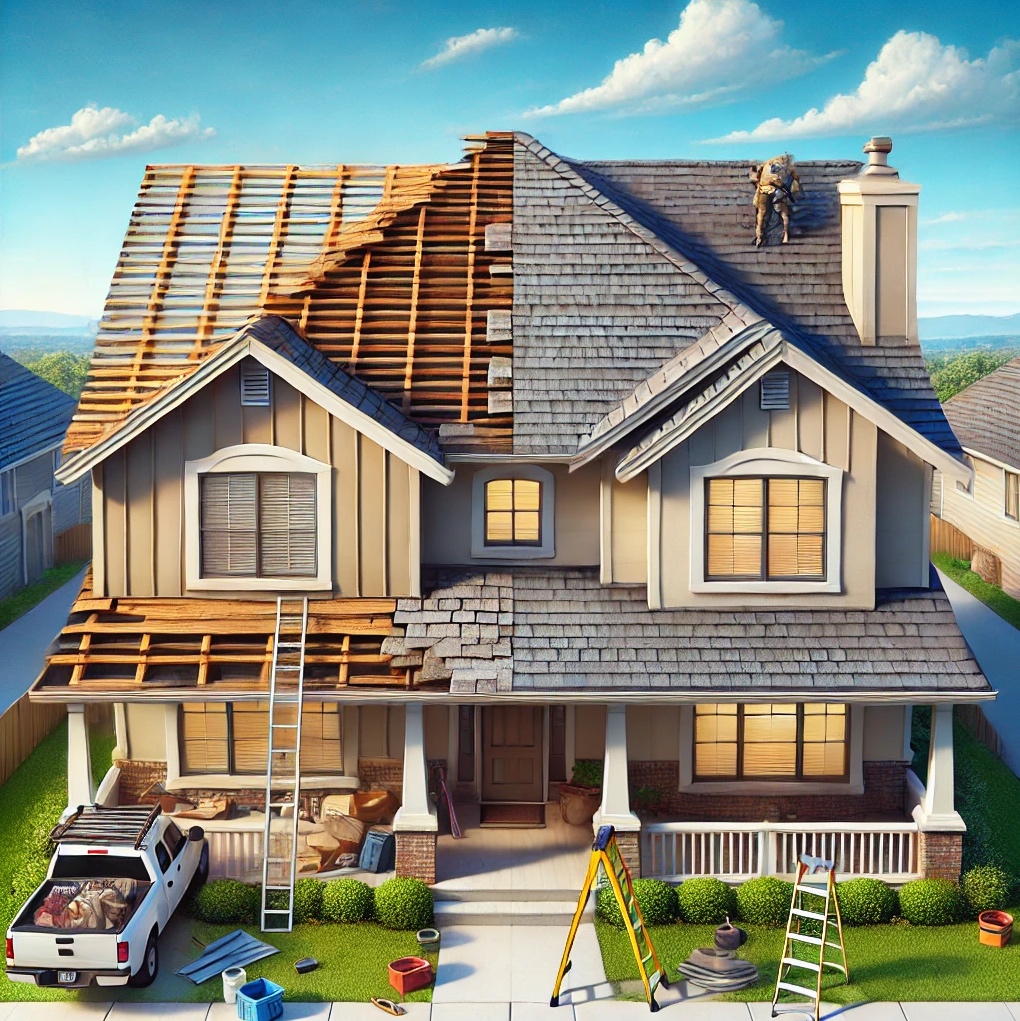Your roof is one of the most critical components of your home, protecting you from the elements and keeping your family safe and comfortable. However, like any part of your house, it won’t last forever. When problems arise—whether it’s a leak, missing shingles, or wear and tear—you’re faced with a crucial decision: should you opt for a roof repair or go for a full roof replacement?
Both options have their pros and cons, and the right choice often depends on the extent of the damage, the age of your roof, and your long-term plans. Let’s break down how to determine when it’s time for a repair versus a replacement.
1. The Age of Your Roof
The lifespan of a roof varies depending on the material used. For example:
- Asphalt shingles (the most common roofing material) last about 20-25 years.
- Metal roofs can last 40-70 years.
- Tile or slate roofs can last over 50 years.
If your roof is approaching or has exceeded its expected lifespan, a full replacement might be the best investment, even if the damage seems minor. Old roofs are more prone to problems, and constant repairs can add up quickly.
When to Repair: If your roof is under 10 years old and the damage is isolated, a repair could be the most cost-effective option.
When to Replace: If your roof is nearing the end of its lifespan, a replacement is often more practical. A new roof can offer better protection and energy efficiency, and it might increase your home’s value.
2. The Extent of Damage
Not all roof damage is created equal. Some problems can be easily repaired, while others indicate more serious structural issues.
Minor Damage: Small leaks, a few missing or cracked shingles, or localized damage from a storm are usually repairable. Addressing these issues promptly can prevent further deterioration.
Major Damage: If a significant portion of your roof is damaged—whether it’s from a severe storm, fallen trees, or years of neglect—it might be time to consider a replacement. Large-scale problems, such as widespread shingle curling, sagging, or multiple leaks, often signal underlying issues that can’t be fixed with a simple repair.
When to Repair: If the damage is localized, affecting less than 30% of the roof, and the rest of the roof is in good condition, repairs should suffice.
When to Replace: If more than a third of your roof is damaged, or if multiple areas show signs of deterioration, a replacement will likely save you money in the long run.
3. Your Long-Term Plans
Your decision between repair and replacement may also depend on how long you plan to stay in your home.
Short-Term Stay: If you’re planning to sell your home in the next few years, a quick repair might be all you need to maintain curb appeal and pass inspections. However, a new roof could also make your home more attractive to potential buyers and boost its resale value.
Long-Term Stay: If this is your forever home, investing in a roof replacement might make more sense. A new roof will give you peace of mind, improve energy efficiency, and reduce the need for ongoing repairs.
When to Repair: If you plan to sell soon and the roof is in relatively good condition, a repair might be enough to pass an inspection and avoid major costs before listing your home.
When to Replace: If you’re staying long-term, a replacement ensures that you won’t have to deal with roof issues for decades, making it a smart investment.
4. The Condition of Your Shingles
Your shingles provide the first line of defense for your roof, so their condition is an important indicator of whether you need a repair or replacement.
Curled or Cracked Shingles: If you notice just a few shingles that are curled, cracked, or missing, these can be replaced individually. However, if a large number of shingles are showing these signs, it indicates aging and weathering across the entire roof.
Granule Loss: Asphalt shingles are coated with granules that help protect your roof from UV rays and water. If you see granules in your gutters or notice “bald” shingles, it could be a sign that your roof is wearing out. Significant granule loss typically means it’s time for a replacement.
When to Repair: If only a few shingles are damaged, a repair can extend the life of your roof.
When to Replace: If a large portion of your shingles show signs of wear, a roof replacement is the better option to avoid recurring problems.
5. Cost Considerations
Roof repairs are generally more affordable than full replacements, but there’s a tipping point where continuing to patch up an aging roof becomes less cost-effective.
Repair Costs: A minor repair could cost a few hundred dollars, depending on the damage. It’s a good short-term solution for minor issues, but recurring repairs can add up over time.
Replacement Costs: A roof replacement is a larger upfront investment but can save you money in the long term by avoiding constant repairs. Plus, a new roof can improve your home’s energy efficiency, saving you on utility bills.
When to Repair: If the repair cost is a fraction of what a replacement would cost and the roof is otherwise in good condition, it’s worth repairing.
When to Replace: If you’re facing frequent repairs and rising costs, a replacement will likely offer better value for your money in the long run.
Conclusion: Repair or Replace?
Deciding between a roof repair and a roof replacement depends on several factors—age, extent of damage, your long-term plans, and cost. If your roof is still relatively new and the damage is minor, repairs can keep your roof functioning for years to come. However, if your roof is nearing the end of its lifespan or has significant damage, investing in a replacement will give you peace of mind and long-term savings.
At Liberty Roofing, we’re here to help you make the right decision for your home. Our team of experienced professionals can assess your roof and recommend the best solution based on its condition and your needs. Contact us today for a free inspection and expert advice on whether it’s time to repair or replace your roof.




